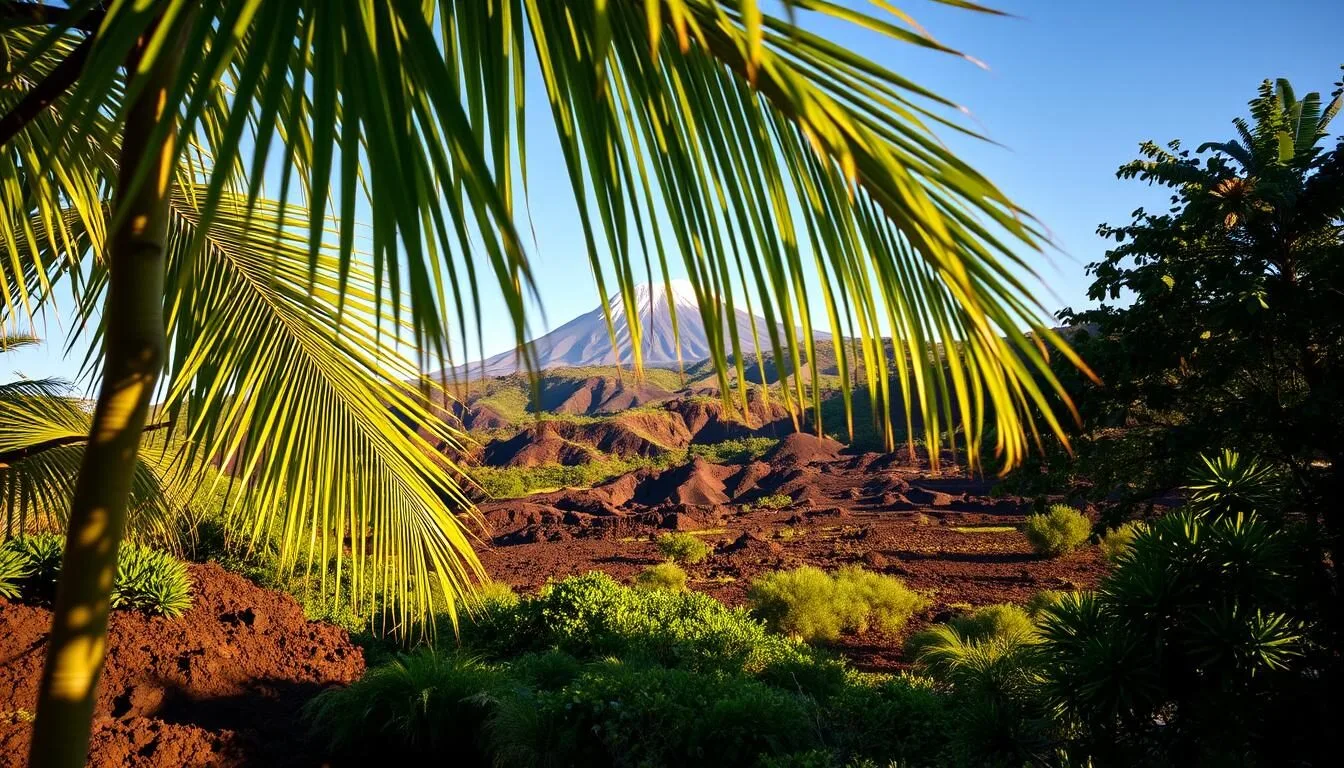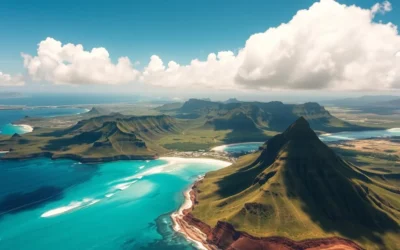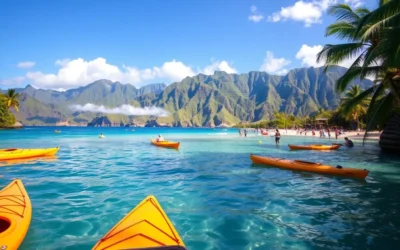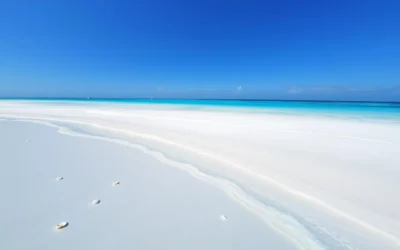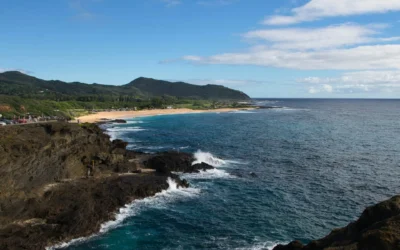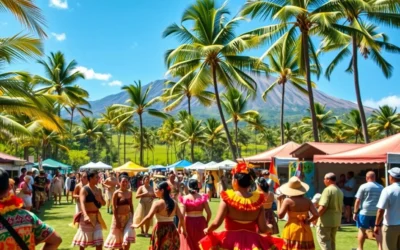✓ Tours & Activities ✓ Tours & Activities
Imagine standing on the edge of a volcanic crater, surrounded by diverse landscapes that range from snowy alpine summits to lush rainforests and multicolored beaches. You’re in for an adventure on the Big Island, the largest of the Hawaiian Islands.
As you explore this paradise, you’ll discover a world of natural wonders, from active volcanoes to pristine beaches. Whether you’re an adventure seeker, nature lover, or history buff, the Big Island has something special for you.
With its unique landscapes and activities, the Big Island offers an incredible variety of experiences that you won’t find anywhere else in the world. Get ready to witness the power of active volcanoes, swim with manta rays, or simply relax on the beach.
Discovering the Big Island’s Diverse Landscapes
As you step foot on the Big Island, you’ll be greeted by a world of contrasting landscapes, from lush rainforests to arid deserts. The island’s unique geography is characterized by five distinct volcanoes, creating microclimates that range from tropical to desert-like conditions within short distances. This diversity makes the Big Island an exciting destination for travelers.
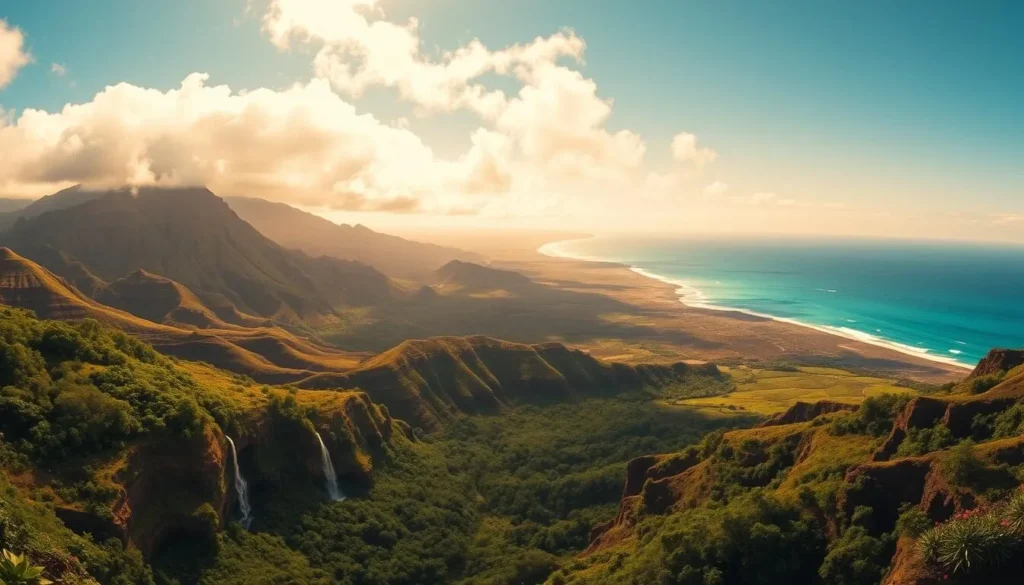
Understanding the Island’s Geography
The Big Island is geographically diverse, with its five volcanoes creating a variety of ecosystems. The west side, particularly around Kailua-Kona, is generally sunny and dry, while the east side, around Hilo, receives abundant rainfall, resulting in lush landscapes and spectacular waterfalls. Understanding this geography is key to planning your visit effectively.
The island’s size and varied landscapes mean that weather conditions can differ significantly from one side to the other. For instance, the Kona side is typically dry and sunny, making it ideal for sunbathing and water activities, while the Hilo side is lush and green, perfect for hiking and exploring nature.
Best Times to Visit the Big Island
The best times to visit the Big Island are during the shoulder seasons, April-May and September-October. These periods offer pleasant weather and fewer crowds, making it easier to explore the island’s attractions. While the island enjoys relatively consistent temperatures year-round, winter brings humpback whales and slightly cooler temperatures, and summer offers warm ocean temperatures and dry conditions on the Hilo side.
If you’re planning to visit during the peak season, be prepared for larger crowds, especially around major attractions and events. However, the consistent temperatures throughout the year make the Big Island a great destination at any time, as long as you’re prepared for the potential crowds.
Getting Around the Island
Getting around the Big Island requires some planning, as public transportation is limited. Renting a car is highly recommended to explore the island freely. The Big Island is significantly larger than other Hawaiian islands, and driving distances can take 2-3 hours from one side to the other. To maximize your vacation time, consider splitting your stay between the Kona and Hilo sides, or even flying into one airport and out of the other.
One-way rental car agreements are not uncommon on the Big Island, making it easier to have a more relaxed experience without the need to backtrack. This flexibility allows you to enjoy the island’s diverse landscapes without the hassle of returning to your starting point.
Hawaii Volcanoes National Park: A Must-Visit Destination
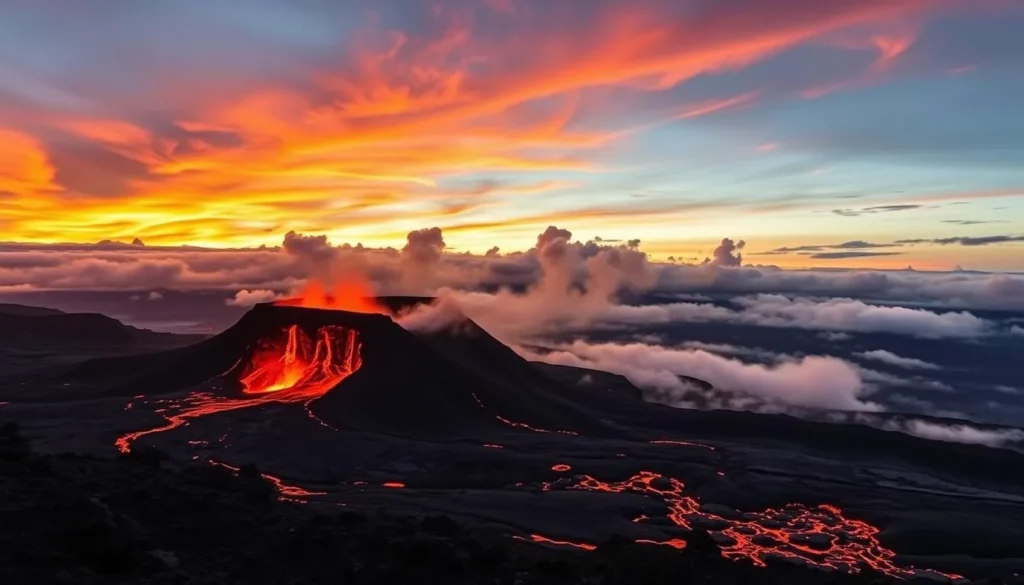
As one of the most unique national parks in the United States, Hawaii Volcanoes National Park is a must-visit destination on the Big Island. This national park is home to two of the world’s most active volcanoes, Kilauea and Mauna Loa, making it a fascinating spot for anyone interested in geology, nature, or simply experiencing the raw power of volcanic activity.
Exploring Kilauea Volcano
Exploring Kilauea Volcano offers a rare opportunity to witness the dynamic forces that shape our planet. Be sure to check at the visitor center for the current eruption status and viewing opportunities, as conditions can change frequently. The volcanic landscapes within the park are not only awe-inspiring but also provide a unique chance to observe geological processes up close.
Hiking the Kilauea Iki Trail
The Kilauea Iki Trail is one of the most spectacular hikes in the park, taking you on a 4-mile loop across a solidified lava lake. This trail descends 400 feet into a crater that was a bubbling lava lake in 1959, offering a glimpse into the park’s volcanic past. The hike is a moderate challenge and provides an unforgettable experience amidst the unique volcanic terrain.
Thurston Lava Tube (Nahuku)
Don’t miss the Thurston Lava Tube, a 500-year-old cave formed by flowing lava. As you walk through this lava tube, you’ll be surrounded by lush rainforest, demonstrating the incredible regenerative power of nature. This natural wonder is a highlight of any visit to Hawaii Volcanoes National Park.
Chain of Craters Road
The Chain of Craters Road is a 19-mile drive from the park’s summit to the sea, passing numerous craters and petroglyphs along the way. This scenic drive ends where lava flows have repeatedly covered the road, a testament to the ongoing volcanic activity in the area. It’s a dramatic and unforgettable journey through some of the park’s most spectacular landscapes.
To make the most of your visit, plan to spend at least a full day in Hawaii Volcanoes National Park. Consider staying in nearby Volcano Village to experience the park at different times of day. The glow of Kilauea’s crater is particularly spectacular after sunset, making it a memorable evening activity.
Mauna Kea: Stargazing at the Top of Hawaii
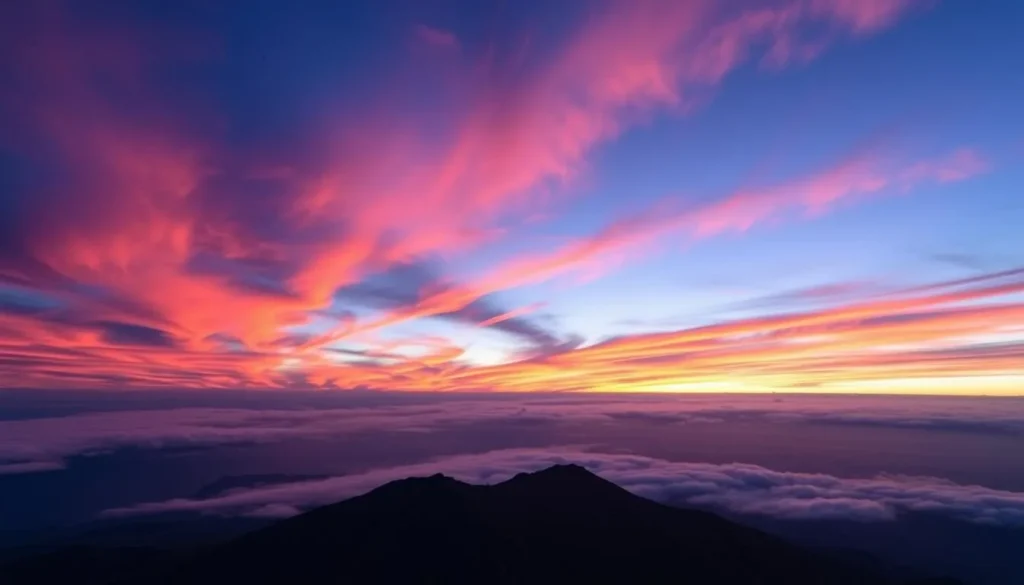
At 13,803 feet, Mauna Kea is not just a mountain, it’s a gateway to the stars. Standing tall on the Big Island, Mauna Kea offers an unparalleled stargazing experience due to its clear, dark skies.
Visiting the Summit
There are three ways to reach the summit of Mauna Kea. If you have a 4×4 vehicle, you can drive up the Mauna Kea Access Road. Alternatively, you can book a guided Mauna Kea tour, which is a hassle-free way to visit the summit. For the adventurous, hiking the Humuʻula Trail is also an option.
Before heading to the summit, it’s essential to be prepared. The temperature can drop below freezing, and altitude sickness is a possibility. Be sure to bring warm clothing, plenty of water, and consider acclimating at the Visitor Information Station at 9,200 feet.
Stargazing Experiences
Mauna Kea is renowned for its exceptional stargazing conditions, with 13 international observatories taking advantage of the clear skies. Guided stargazing tours often include powerful telescopes, allowing you to witness celestial wonders such as planets, star clusters, and distant galaxies.
These tours typically take you from sea level to the summit, providing a unique perspective on the night sky. Some tours include food and beverages, while others allow you to bring your own snacks.
The Humuʻula Trail for Adventurous Hikers
For experienced hikers, the Humuʻula Trail offers a challenging 6.9-mile one-way hike with approximately 4,600 feet of elevation gain. This strenuous hike requires acclimation to high altitudes and proper preparation.
The trail provides a unique opportunity to experience the rugged terrain and breathtaking views of Mauna Kea. Ensure you’re well-prepared with the right gear and knowledge before embarking on this adventure.
Unforgettable Water Adventures on the Big Island
Dive into the crystal-clear waters of the Big Island and discover a world of underwater wonders. The Big Island is a paradise for water enthusiasts, offering a variety of activities that cater to all ages and preferences.
Night Snorkel with Manta Rays
Imagine snorkeling with giant manta rays under the stars. The Night Snorkel with Manta Rays tour is a magical experience that takes place in the evening. You’ll float on the surface of the water, holding onto a lighted raft, as these gentle giants glide inches from you, feeding on plankton attracted to the light.
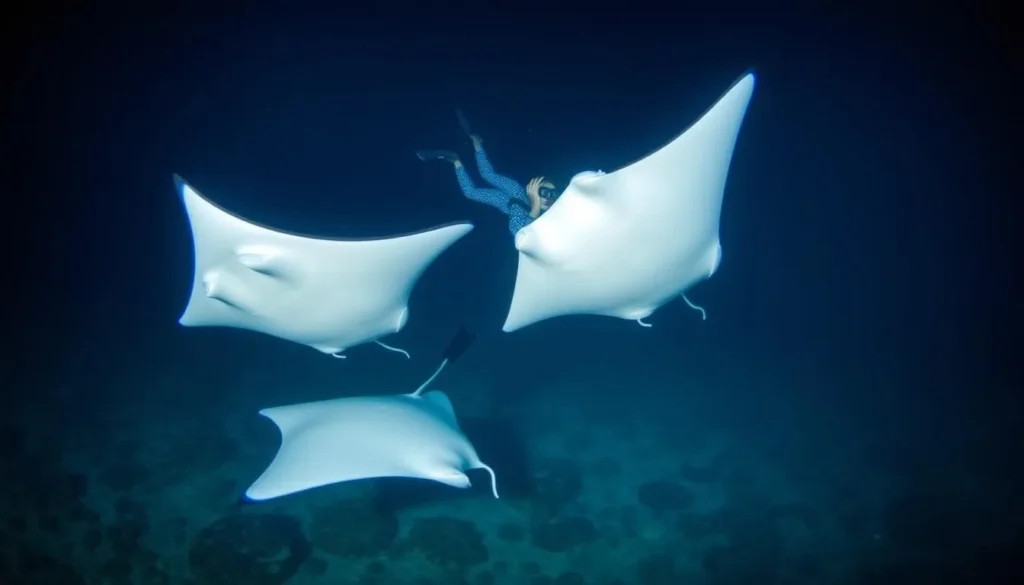
Best Snorkeling Spots: Kealakekua Bay and Two Step
The Big Island is home to some of the best snorkeling spots in Hawaii. Kealakekua Bay offers exceptional water clarity and abundant marine life, making it a must-visit destination. You can access the bay via a boat tour or a guided kayak tour. Another premier snorkeling spot is Two Step (Honaunau Bay), where you can easily enter the water from natural lava “steps” and encounter colorful fish, coral formations, and possibly sea turtles.
Whale Watching (Winter Only)
During the winter months (December to April), the Big Island becomes a haven for humpback whales. Take a whale watching tour to observe these majestic creatures as they migrate to Hawaii’s warm waters to breed and give birth. Witness spectacular breaches, tail slaps, and maybe even hear whale songs through hydrophones.
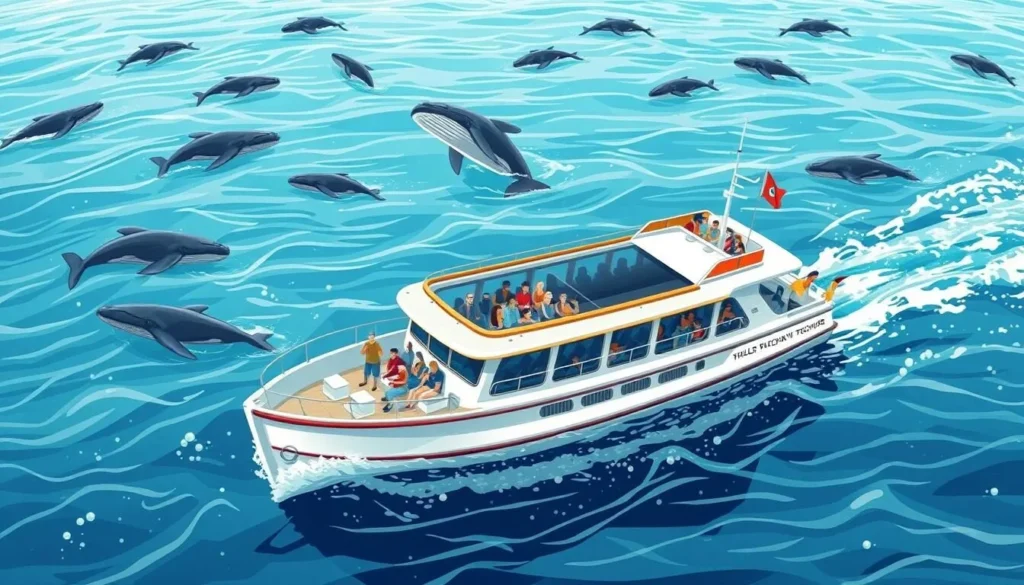
To make the most of your water adventures on the Big Island, remember to book your tours in advance, especially the popular manta ray night snorkel, which often sells out. Always respect marine life by maintaining an appropriate distance and using reef-safe sunscreen.
The Big Island’s Stunning Beaches
From pristine white sand to striking black sand and rare green sand beaches, the Big Island’s coastline is a treasure trove of natural wonders. The island’s unique volcanic activity has created a diverse range of beaches, each offering a distinct experience for visitors.
Hapuna Beach: White Sand Paradise
Hapuna Beach is consistently ranked as one of America’s best beaches, boasting a half-mile stretch of perfect white sand and crystal-clear waters. It’s an ideal spot for swimming, bodyboarding, and sunbathing, with excellent facilities to ensure a comfortable visit.
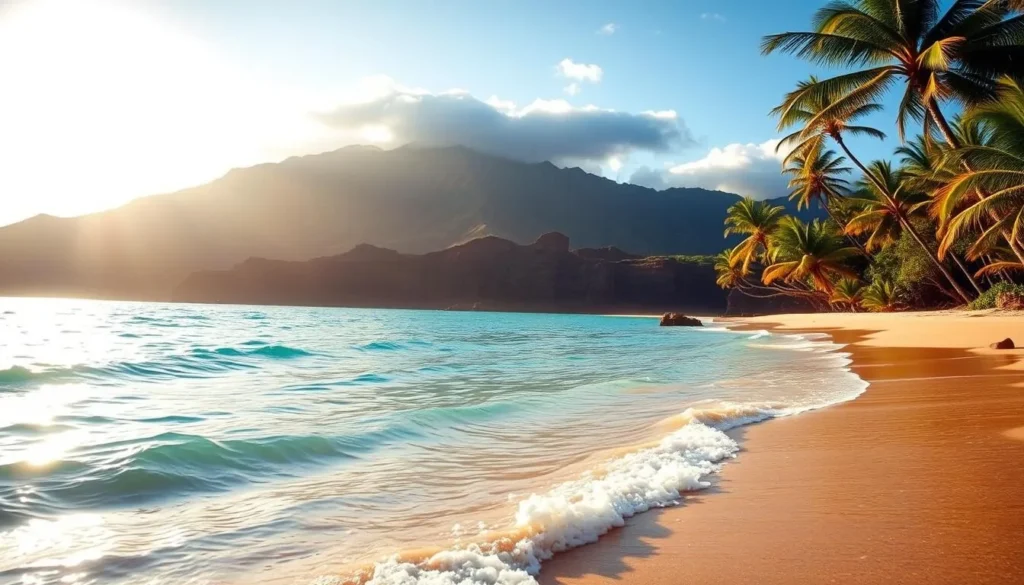
Punalu’u: The Famous Black Sand Beach
Punalu’u Black Sand Beach is a striking contrast to the traditional white sand beaches, with its jet-black shoreline created by lava flowing into the ocean and cooling rapidly. This beach is also a favorite resting spot for Hawaiian green sea turtles, adding to its unique charm.
Papakōlea: One of the World’s Few Green Sand Beaches
Papakōlea, or Green Sand Beach, is one of only four green sand beaches in the world. Its olive hue is derived from the mineral olivine found in the surrounding cinder cone. Reaching this beach requires a 2.5-mile hike each way or a local shuttle service, making it an adventure worth undertaking.
| Beach Name | Sand Color | Activities | Accessibility |
|---|---|---|---|
| Hapuna Beach | White | Swimming, Bodyboarding, Sunbathing | Easy |
| Punalu’u Black Sand Beach | Black | Wildlife Watching, Photography | Moderate |
| Papakōlea Green Sand Beach | Green | Hiking, Exploring | Challenging (2.5-mile hike) |
Each of these beaches offers a unique experience, showcasing the Big Island’s geological diversity. Whether you’re looking to relax on soft sand, explore the underwater world, or embark on a hiking adventure, the Big Island’s beaches have something for everyone.
Chasing Waterfalls on the Hilo Side
If you’re looking for breathtaking waterfalls, the Hilo side of the Big Island is a must-visit destination, boasting some of Hawaii’s most spectacular falls. The region’s abundant rainfall creates lush landscapes, making it a perfect setting for nature’s wonders.
Akaka Falls State Park
Akaka Falls State Park is home to the stunning 442-foot Akaka Falls, a breathtaking sight that’s easily accessible via a paved 0.4-mile loop trail through a lush rainforest. With an entrance fee of $5 and a $10 parking fee for non-residents, it’s a worthwhile experience. The falls are located just a few miles outside of Hilo along the Hāmākua Coast, making it a great stop on your way to or from Hilo.
Rainbow Falls (Waianuenue)
Another beautiful drive-up waterfall on the east side of the Big Island is Rainbow Falls, conveniently located within Hilo town. Visiting in the morning when the sun is behind you offers the best chance to see the rainbows that give this 80-foot waterfall its name. It’s a perfect quick stop when you don’t have much planned for the day.
Pe’epe’e Falls and Boiling Pots
Just 1.5 miles upstream from Rainbow Falls are Pe’epe’e Falls and the Boiling Pots, featuring unique geological formations. The Wailuku River has carved pools into the lava rock, creating a “boiling” effect during high water flow. This area offers relatively easy access with minimal hiking required, making it perfect for families or those with limited mobility.
The Hilo side of the Big Island receives abundant rainfall, creating lush landscapes and spectacular waterfalls that are easily accessible. Be sure to see as many as you can when you’re here, as the east side of the island is significantly wetter than the Kona side. Prepare for rain showers and bring appropriate footwear for potentially muddy conditions.
The Big Island, Hawaii: Best Things to Do for Adventure Seekers
The Big Island is a paradise for adventure seekers, offering a wide range of activities that combine adrenaline with the island’s unique natural features. Whether you’re looking for a bird’s-eye view of the island, an adrenaline rush through the forests, or a serene paddleboarding experience under the stars, the Big Island has something for everyone.
Helicopter Tours Over Active Volcanoes
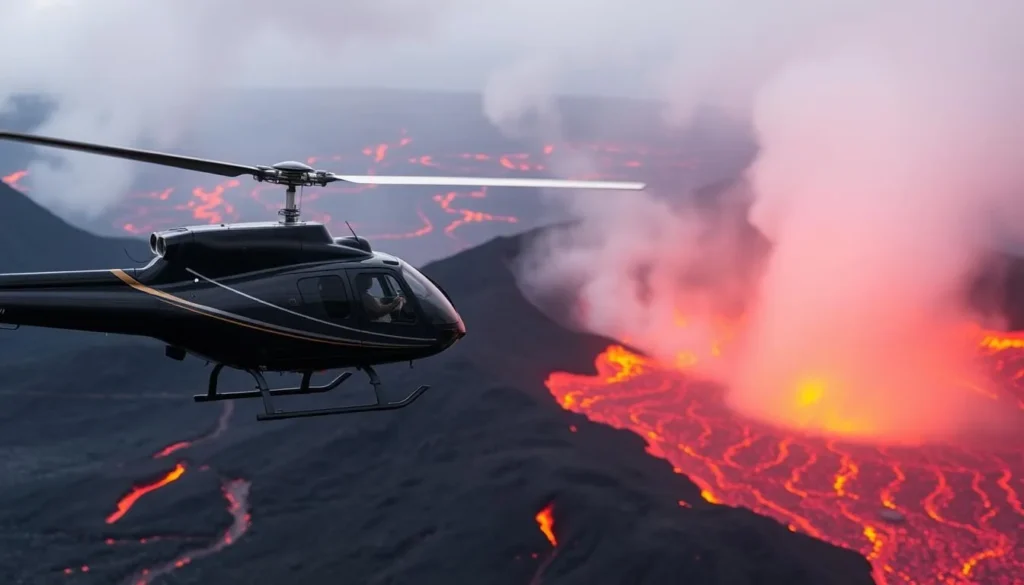
A Big Island helicopter tour is a must-do experience, especially during volcanic eruptions. You’ll witness the island’s active volcanoes from a unique perspective, seeing glowing lava flows, massive craters, and hidden waterfalls that are inaccessible by land. Different helicopter tour options focus on specific areas, such as circling the entire island, exploring Hawaii Volcanoes National Park, or viewing the dramatic sea cliffs and waterfalls of the Kohala Coast.
Ziplining Through Tropical Forests
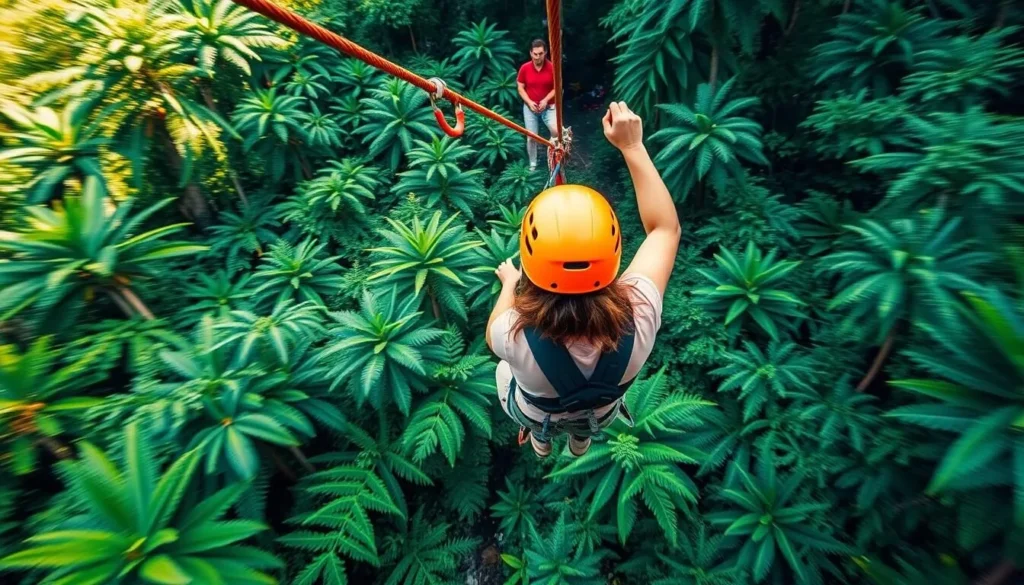
For a thrilling experience, ziplining through the Big Island’s tropical forests offers a bird’s-eye view of the island’s lush landscapes. Courses are available near Hilo and in the Kohala area, ranging from beginner-friendly to heart-pounding adventures. You’ll soar through the trees, taking in the breathtaking views and enjoying an adrenaline rush like no other.
Stand Up Paddleboarding at Night
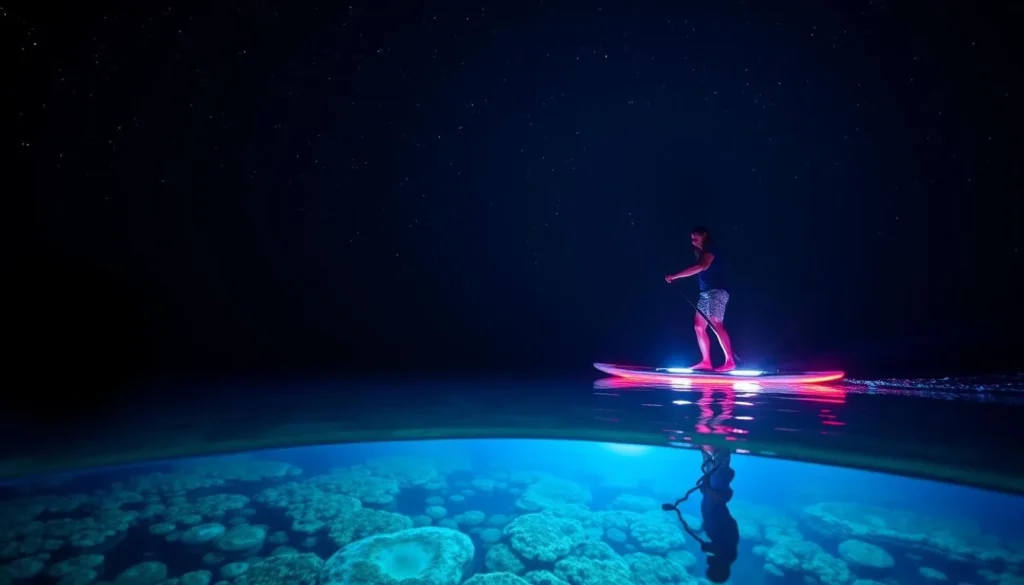
Experience the Big Island in a unique way with a sunset paddleboard tour. Companies like LightSUP Hawaii offer custom boards with lights and a clear panel, allowing you to see the reef below even at night. It’s a fun mix of stand-up paddleboarding and snorkeling, providing an unforgettable experience under the stars.
These adventure activities provide perspectives of the Big Island that can’t be experienced any other way, making them worth the splurge for unforgettable vacation memories. Whether you’re a seasoned adventurer or just looking to try something new, the Big Island has something to offer.
Hiking Trails for All Skill Levels
Whether you’re a seasoned hiker or just starting out, the Big Island has a trail that’s perfect for you. The island offers a diverse range of hiking experiences, from easy nature walks to challenging multi-day adventures, all showcasing the island’s diverse ecosystems and breathtaking views.
Pololu Valley Trail
The Pololu Valley Trail is a relatively short but steep 0.6-mile descent to a black sand beach with spectacular views of the dramatic northeastern coastline and lush valley. This trail is perfect for intermediate hikers looking to experience the island’s unique landscapes.
Trail Details: Distance – 0.6 miles, Difficulty – Intermediate
Waipio Valley Lookout and Beach
The Waipio Valley Lookout provides stunning panoramic views of the “Valley of the Kings” with its black sand beach and 2000-foot cliffs. While access to the valley floor is restricted to residents and tour vehicles, the lookout itself is easily accessible and offers a glimpse into the island’s rich history and natural beauty.
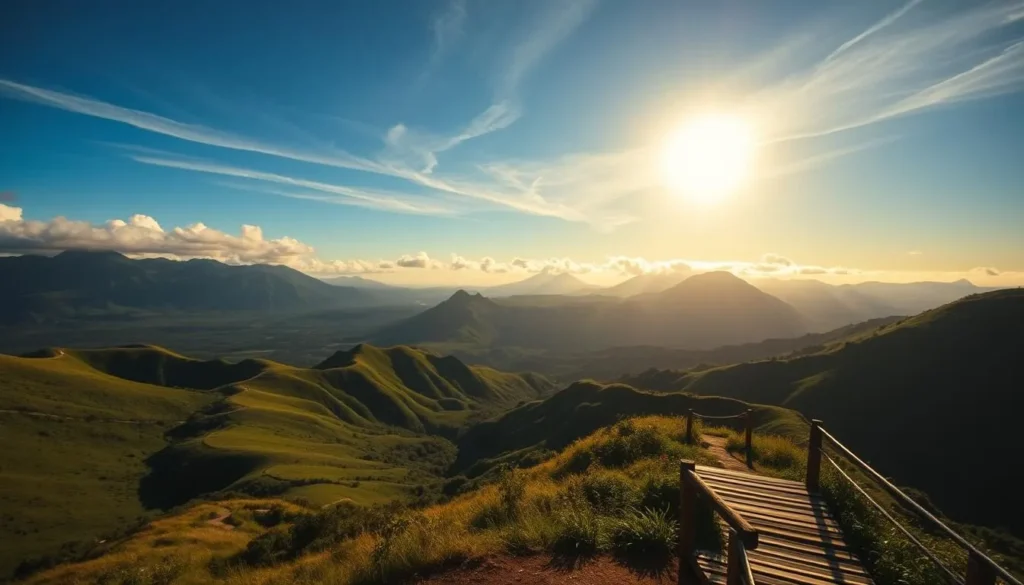
Kaulana Manu Nature Trail
The Kaulana Manu Nature Trail is a hidden gem off Saddle Road, offering an easy 0.6-mile loop through pristine native Hawaiian forest. This trail is ideal for families and nature lovers, providing excellent opportunities for bird watching and experiencing one of the most intact native ecosystems on the island.
| Trail Name | Distance | Difficulty |
|---|---|---|
| Pololu Valley Trail | 0.6 miles | Intermediate |
| Waipio Valley Lookout | N/A | Easy |
| Kaulana Manu Nature Trail | 0.6 miles | Easy |
When hiking on the Big Island, it’s essential to check weather conditions before setting out, bring plenty of water, wear appropriate footwear, and be aware that trail conditions can change rapidly, especially after rainfall. Many trails cross private property or culturally significant areas, so always stay on marked paths, respect closure signs, and leave no trace to help preserve these special places for future visitors.
Cultural and Historical Sites
As you explore the Big Island, you’ll discover a wealth of cultural and historical sites that offer insights into Hawaii’s fascinating past. The island is rich in Hawaiian history and culture, with numerous well-preserved sites that provide a glimpse into ancient Hawaiian traditions and the island’s complex past.
Pu’uhonua o Hōnaunau National Historical Park
Located next to Two Step, Pu’uhonua o Hōnaunau National Historical Park is one of the best places to visit on the Big Island to learn about Hawaiian history and culture. This sacred site was a place of refuge in ancient Hawaii for those who broke kapu (sacred laws). You can explore the royal grounds, massive lava rock walls, and reconstructed temples by following the 0.5-mile self-guided trail.
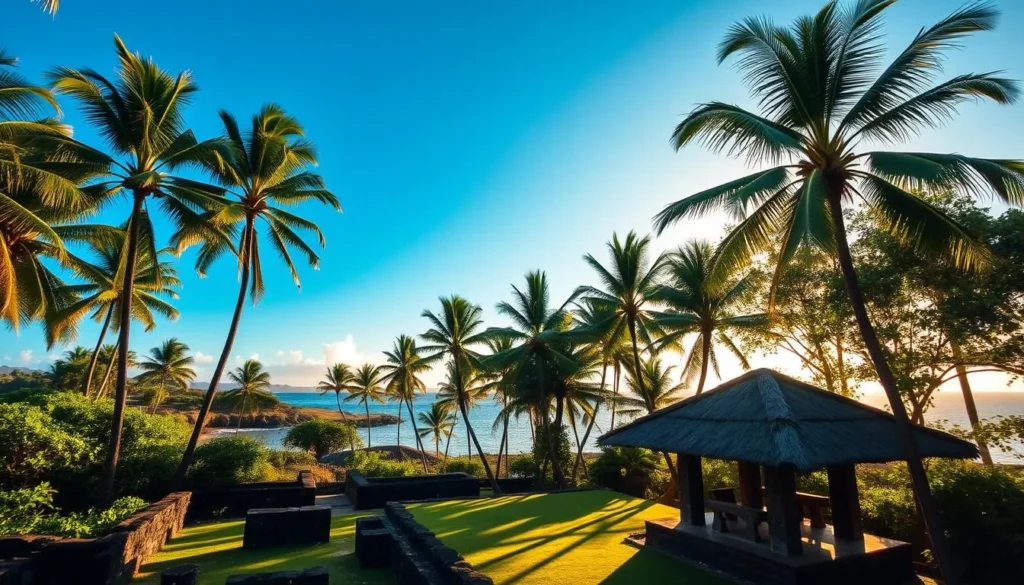
The Royal Grounds give a sense of traditional Hawaiian villages and were a center of power only open to ali’i (royal chiefs) and those who served them. You can see the Hale o Keawe Temple, which housed the bones of the ali’i, a canoe house, fishponds, and even games like kōnane.
Puako Petroglyph Archaeological Preserve
The Puako Petroglyph Archaeological Preserve contains over 3,000 petroglyphs (rock carvings) dating back hundreds of years. Follow the short trail through kiawe trees to see these ancient images depicting people, animals, and symbols of Hawaiian life. This preserve provides a unique glimpse into the lives of ancient Hawaiians and their cultural practices.
| Cultural Site | Location | Significance |
|---|---|---|
| Pu’uhonua o Hōnaunau | Next to Two Step | Place of refuge for those who broke kapu |
| Puako Petroglyph Archaeological Preserve | Puako | Over 3,000 petroglyphs depicting ancient Hawaiian life |
| Hulihee Palace | Kailua-Kona | 19th-century vacation home for Hawaiian royalty |
Hulihee Palace in Kailua-Kona
Hulihee Palace in Kailua-Kona served as a vacation home for Hawaiian royalty during the 19th century and now operates as a museum showcasing furniture, artifacts, and personal items belonging to Hawaiian monarchs. You can explore the palace and learn about the history of Hawaiian royalty and their cultural practices.
These cultural sites provide a deeper understanding of Hawaiian history beyond the beaches and volcanoes, offering context for the islands’ complex cultural heritage and the significant changes that occurred after Western contact.
Exploring the Kona Coffee Country
A trip to the Big Island isn’t complete without experiencing the world of Kona coffee. The Kona coffee region, located on the western slopes of the Big Island, is famous for producing some of the world’s highest-quality coffee.
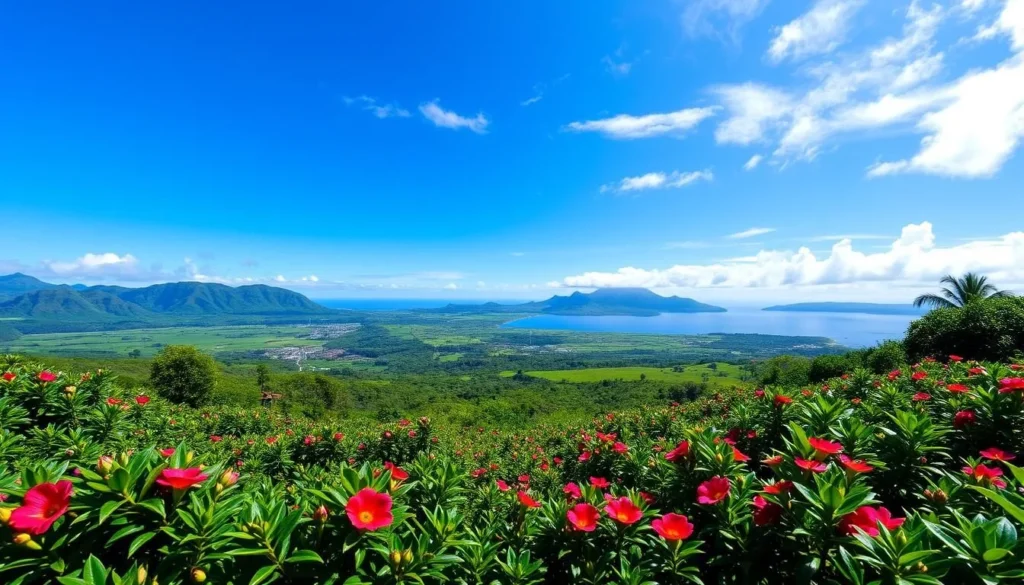
Coffee Farm Tours and Tastings
The Kona Coffee Belt is known for its ideal coffee-growing conditions, including rich volcanic soil and optimal climate. You can explore this region through various coffee farm tours, which offer insights into the coffee production process from cherry to cup.
Popular farms include Greenwell Farms, known for its free tours and tastings, and Mountain Thunder, an organic coffee plantation. The Kona Coffee Living History Farm provides a unique experience, showcasing what coffee farming was like in the 1920s.
The Coffee Shack: Views and Brews
For a memorable coffee experience, visit The Coffee Shack in Captain Cook, perched 1,400 feet above Kealakekua Bay. It offers not only great coffee but also panoramic views spanning 26 miles of coastline.
Best Coffee Shops on the Island
To fully appreciate Kona coffee, visit local coffee shops like Hilo Coffee Mill on the east side and Kona Coffee & Tea Company in Kailua-Kona. These shops allow you to taste the difference between authentic Kona coffee and blends.
Be sure to check the labeling; true Kona coffee must be grown within the Kona district and labeled “100% Kona Coffee.” Many “Kona Blends” may contain as little as 10% actual Kona beans.
Local Cuisine and Dining Experiences
From traditional Hawaiian dishes to modern fusion cuisine, the Big Island’s food scene is as diverse as its landscapes. The island’s culinary identity is shaped by its cultural heritage and the abundance of fresh, local ingredients. You can experience this diversity firsthand by exploring the various dining options available across the island.
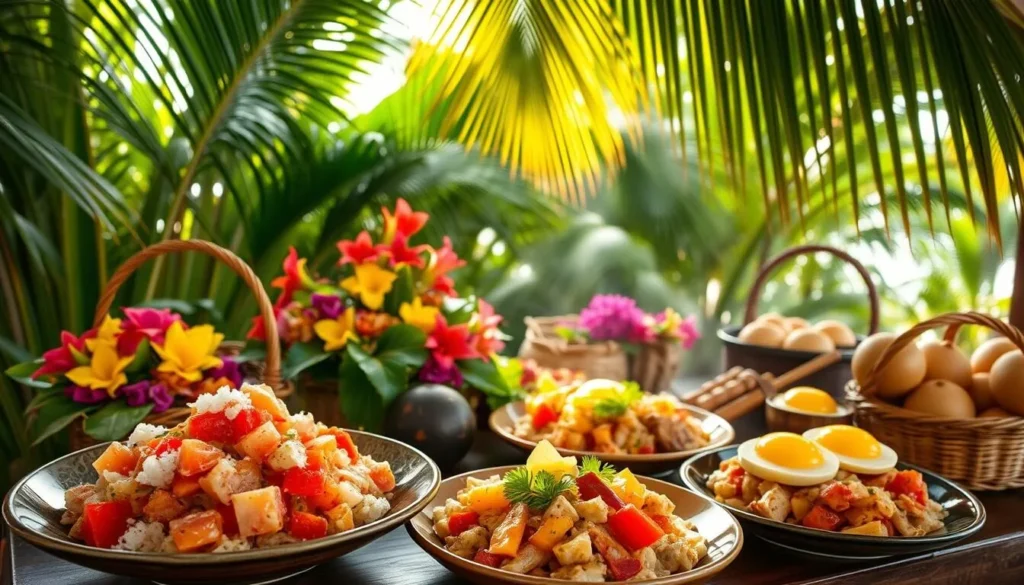
Traditional Hawaiian Food to Try
When visiting the Big Island, be sure to try some traditional Hawaiian dishes that reflect the island’s rich cultural heritage. You can savor poke, made from seasoned raw fish, and laulau, which consists of meat wrapped in taro leaves. Other local favorites include kalua pig, slow-roasted pork, and poi, a fermented taro paste. Don’t miss the opportunity to taste loco moco, a classic dish featuring rice topped with a hamburger patty, fried egg, and gravy.
For an authentic experience, head to Big Island Grill to taste traditional Hawaiian food. You can also grab a local plate lunch at L&L Hawaiian Barbecue or Ippy’s Hawaiian BBQ. For a taste of locally grown, grass-fed beef, visit Foster’s or Village Burger. Cafe100 is a must-visit for trying the original loco moco at its birthplace.
Best Restaurants in Kona
Kona’s restaurant scene offers a range of dining experiences, from casual beachside eateries to upscale restaurants. You should not miss Merriman’s, a pioneer in farm-to-table cuisine, or Da Poke Shack for fresh seafood. For a memorable dining experience with sunset views, head to Huggo’s, which offers oceanfront dining.
The food truck scene in Kona is also worth exploring. You can find some of the island’s most authentic and affordable dining experiences at food trucks like Fresh Off the Grid, Island Style Grindz, Da Fish House, and The Rendezvous Truck.
Best Restaurants in Hilo
Hilo’s food scene is more local-focused and generally more affordable than Kona’s. You can visit Cafe100, known as the birthplace of loco moco, or Suisan Fish Market for fresh poke. For upscale local cuisine with bay views, dine at Hilo Bay Cafe. Exploring the local eateries and food trucks in Hilo is a great way to experience the authentic flavors of the Big Island.
The Big Island’s agricultural abundance means that farm-to-table dining is not just a trend but a way of life. Many restaurants source their ingredients from local farms, ranches, and fishermen, creating uniquely Hawaiian dining experiences. Whether you’re dining on the beach side or at a local eatery, you’re sure to enjoy the rich flavors and diversity of the Big Island’s cuisine.
Farmers Markets and Local Shopping
The Big Island’s farmers markets are a treasure trove of local culture and cuisine, offering a unique way to experience the island’s vibrant community. When you visit these markets, you’re not just shopping; you’re immersing yourself in the local way of life.
Hilo Farmers Market
The Hilo Farmers Market is the island’s largest and most famous, operating daily but peaking on Wednesdays and Saturdays with over 200 vendors. Here, you can find everything from exotic fruits like lilikoi (passion fruit) and rambutan to handmade crafts and prepared foods. It’s a great place to taste new ‘ono foods and support local growers. Visiting this market is one of the best things to do on the Big Island in a day.
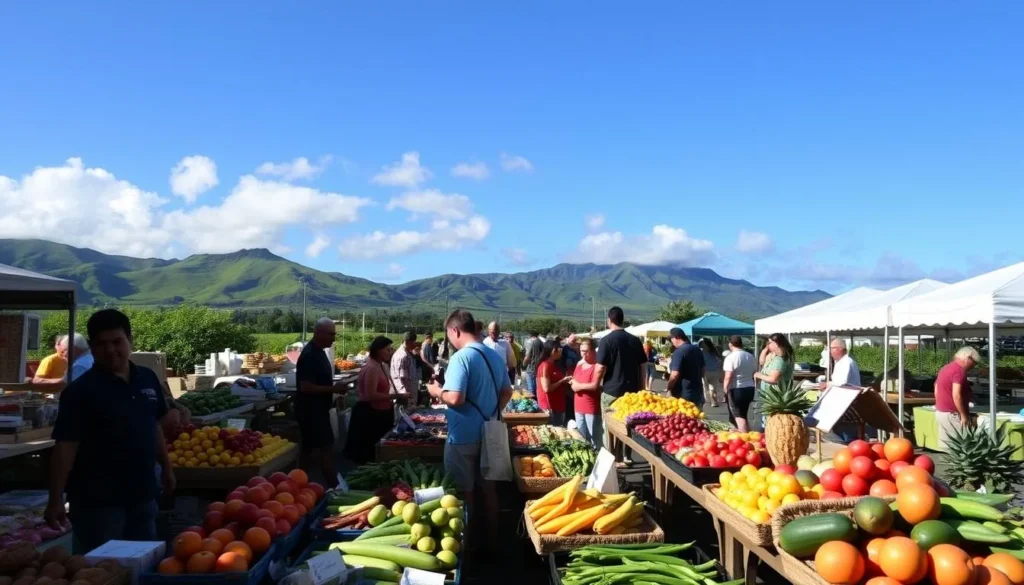
Kona Village Farmers Market
On the west side of the island, the Kona Village Farmers Market provides a similar experience, operating from Wednesday through Sunday. You’ll find a wide variety of local produce, flowers, coffee, and crafts in a convenient location near downtown Kailua-Kona. This market is an excellent place to buy food and other local products, giving you a taste of the island’s rich agricultural offerings.
Souvenirs and Local Crafts
Both the Hilo and Kona Village Farmers Markets are excellent places to find authentic Hawaiian souvenirs, including Kona coffee, macadamia nuts, local honey, handcrafted jewelry, and artwork. Shopping at these markets not only supports local artisans but also gives you the opportunity to take home unique gifts. Remember to visit early in the day for the best selection and be prepared to pay with cash, as not all vendors accept credit cards.
By shopping at these markets, you’re supporting the local economy and experiencing the Big Island’s culture firsthand. It’s a wonderful way to spend your time on the island, discovering local crafts and enjoying the community atmosphere.
Nightlife and Evening Entertainment
The Big Island’s evening entertainment scene is a perfect blend of relaxation and cultural experiences. As the sun sets, the island transforms into a vibrant destination with various activities to enjoy.
Attending a Traditional Luau
Attending a traditional luau is a quintessential Hawaiian experience. You can enjoy a feast of local Hawaiian foods like kalua pig, poi, and haupia while watching performances that tell the story of Hawaii through hula and other Polynesian dances.
Popular luaus include the Voyagers of the Pacific Luau at the Royal Kona Resort, the Island Breeze Luau at the Courtyard King Kamehameha’s Kona Beach Hotel, and the Legends of Hawaii Luau at the Hilton Waikoloa Village.
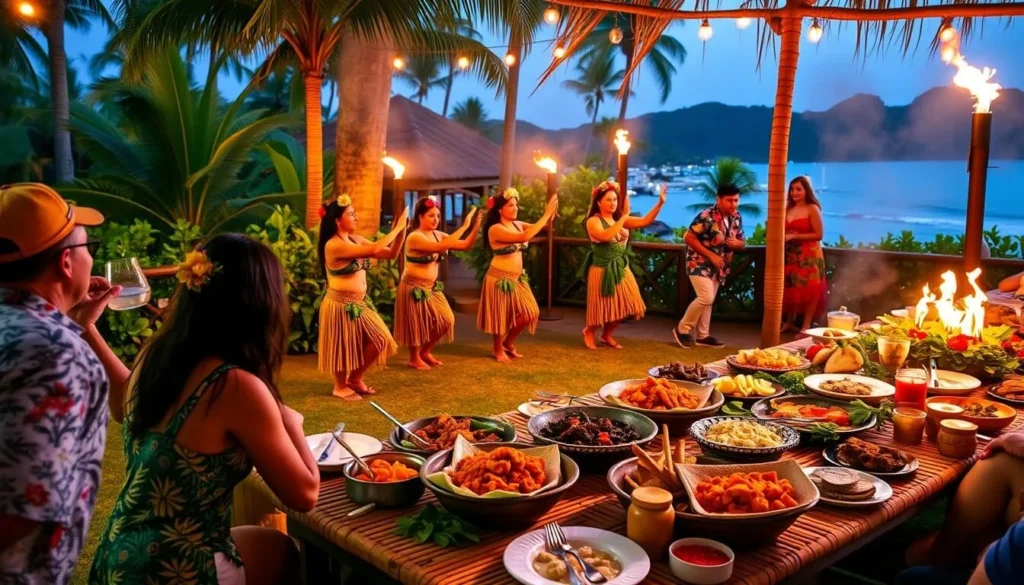
Live Music Venues
Live music venues are scattered throughout the island, particularly in Kailua-Kona. Establishments like Huggo’s on the Rocks, Gertrude’s Jazz Bar, and the Kona Brewing Company offer regular performances ranging from traditional Hawaiian music to contemporary styles.
Sunset Spots and Beach Bars
The Big Island offers spectacular sunset viewing locations. Beach bars like Lava Lava Beach Club in Waikoloa provide the perfect setting to enjoy tropical cocktails while watching the sun sink into the Pacific.
For a unique evening experience, consider joining a night snorkel with manta rays or attending a stargazing tour at Mauna Kea.
Day Trips and Scenic Drives
Discover the Big Island’s hidden gems on a day trip or scenic drive, exploring the island’s unique environments and attractions. The Big Island’s massive size and diverse landscapes make it perfect for day trips and scenic drives that showcase dramatically different environments within a single day.
South Point: The Southernmost Point in the U.S.
South Point, or Ka Lae, is the southernmost point in the United States, offering dramatic coastal views, strong winds that have bent trees permanently sideways, and for the adventurous, a famous cliff jumping spot. However, extreme caution is advised due to huge surf and hidden ocean currents. Always check the ladder’s presence and condition before jumping, and consider the locals’ advice on the conditions.
Driving the Hamakua Coast
The Hamakua Coast drive along Highway 19 north of Hilo is a breathtaking journey through lush rainforests, dramatic sea cliffs, and numerous waterfalls. Plan to stop at scenic overlooks, botanical gardens, and charming towns like Honoka’a along the way, immersing yourself in the natural beauty of the Big Island’s coast.
Circle Island Tour
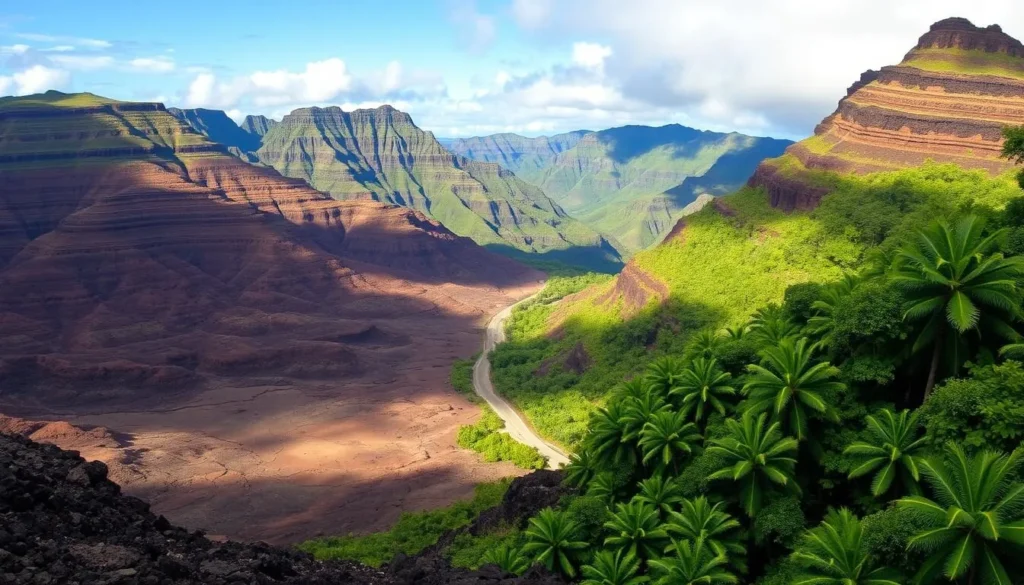
A full circle island tour is an ambitious but achievable day trip, requiring around 8-10 hours of driving plus stops. This epic road trip takes you through all the major climate zones, from lava deserts to tropical rainforests, offering a comprehensive experience of the Big Island’s diverse landscapes. Don’t rush; build in time for spontaneous stops at roadside fruit stands, unexpected viewpoints, and hidden beaches you’ll discover along the way.
Whether you’re driving along the Hamakua Coast, exploring South Point, or embarking on a Circle Island Tour, each day trip or scenic drive on the Big Island offers a unique and unforgettable experience. Take your time, enjoy the views, and discover the many wonders of this incredible island.
Where to Stay on the Big Island
Selecting the perfect place to stay on the Big Island depends on understanding the unique characteristics of each region. The island offers a diverse range of accommodations to suit every traveler’s needs, from luxury resorts to budget-friendly options.
Kona and the Kohala Coast
The west side of the Big Island, including Kona and the Kohala Coast, is known for its sunny weather, beautiful beaches, and numerous resort options. This area is ideal for those prioritizing beach time and water activities. Luxury resorts like the Fairmont Orchid and Westin Hapuna Beach Resort are located along the Kohala Coast, offering high-end amenities and stunning ocean views. In Kailua-Kona, you’ll find more affordable options and a livelier atmosphere with restaurants and shops within walking distance.
| Location | Accommodation Type | Highlights |
|---|---|---|
| Kona | Budget-friendly hotels and vacation rentals | Lively atmosphere, restaurants, and shops within walking distance |
| Kohala Coast | Luxury resorts | Stunning ocean views, high-end amenities |
Hilo and the East Side
Hilo and the east side of the Big Island offer a more authentic, less touristy Hawaiian experience. This region is characterized by lush landscapes, easy access to waterfalls, and significantly lower accommodation prices. However, expect more rainfall and fewer swimming beaches compared to the west side.
Volcano Village
For those interested in exploring Hawaii Volcanoes National Park, Volcano Village is an ideal location. This area offers unique accommodations in rainforest settings, allowing visitors to experience the park at different times of the day and avoid long drives from other parts of the island. Staying in Volcano Village provides a tranquil atmosphere and proximity to one of the Big Island’s most significant attractions.
Consider splitting your stay between different areas of the Big Island to minimize driving time and experience the diverse regions. Many visitors divide their stay between the Kona/Kohala area and either Hilo or Volcano, enjoying the best of what the Big Island has to offer.
Conclusion: Making the Most of Your Big Island Adventure
Embarking on a journey to the Big Island means immersing yourself in Hawaii’s most diverse island. With its unique blend of natural wonders, cultural sites, and adventure activities, the Big Island truly lives up to its name.
The island offers an incredible diversity of experiences packed into one island, from active volcanoes to pristine beaches, cultural sites to coffee farms. To make the most of your Big Island adventure, consider spending at least 5-7 days on the Big Island and splitting your stay between different regions to minimize driving time and maximize experiences.
Don’t try to see everything in one trip; instead, prioritize things to do based on your interests and leave time for spontaneous discoveries and relaxation. The Big Island rewards those who embrace its slower pace and take time to connect with local culture by attending farmers markets, talking to residents, and learning about the island‘s rich history and traditions.
Consider the timing of your visit to the Hawaiian island; winter brings humpback whales and potentially snowy views of Mauna Kea, while summer offers drier conditions on the Hilo side and warmer ocean temperatures. Whatever your interests, the Big Island offers a more authentic Hawaiian experience than some of the more developed islands, with plenty of space to explore away from crowds and connect with Hawaii’s natural beauty and cultural heritage in your own way.
For those looking for guided experiences, various tours are available, ranging from helicopter tours over active volcanoes to snorkeling and diving excursions. Whether you’re looking to relax on a serene beach or explore the island’s many wonders, the Big Island has something for every type of traveler.
The above is subject to change.
Check back often to TRAVEL.COM for the latest travel tips and deals.
